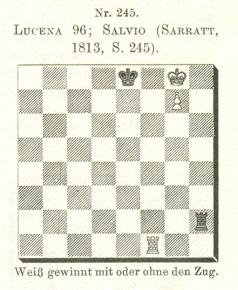
Edward Winter
From Jud McCranie (Brunswick, GA, USA):
‘Did the Lucena Position appear in Lucena’s 1497 book? I have several good sources saying that it did, but several good sources saying that it did not. Some credit Salvio, 1634.’
We believe that this matter was resolved by John Roycroft in an article on pages 160-161 of the April 1982 BCM. Supported by Ricardo Calvo (‘who has made a special study of Lucena and is familiar with every position of the original’), he stated that the position was not in Lucena’s book and suggested that the attribution was due to an error by Johann Berger on page 273 of Theorie und Praxis der Endspiele (Berlin and Leipzig, 1922):

John Roycroft added:
‘In fact the position is indeed to be found in “Salvio”, namely on page 69 of Dr Alessandro Salvio’s Il Puttino, dated 1634. This work is a romance on the chess and non-chess life of Leonardo Giovanni da Cutro, whose rivals included his fellow Italian Paolo Boi and the Spaniard Ruy López. The attribution by Salvio of our position is to “Scipione Genovino”, and the play is given.’
On pages 495-496 of the November 1982 BCM Ricardo Calvo contributed a follow-up item which described Roycroft’s article as ‘very accurate’.
We note that the position as given by Salvio (i.e. the mirror image of what appeared in Berger’s book, with the white rook on c1) was included in an article about him by J.A. Leon on pages 1-8 of the January 1895 BCM.
(5536)
Leonard McLaren (Onehunga, New Zealand) asks about the origins of the phrase ‘building a bridge’ and wonders whether it is a misnomer.
The manoeuvre in question, in the so-called ‘Lucena Position’, was discussed in C.N. 5536. The bridge-building term (Der Brückenbau) appeared in Chapter VI of Nimzowitsch’s Mein System (Berlin, 1925). From page 117:
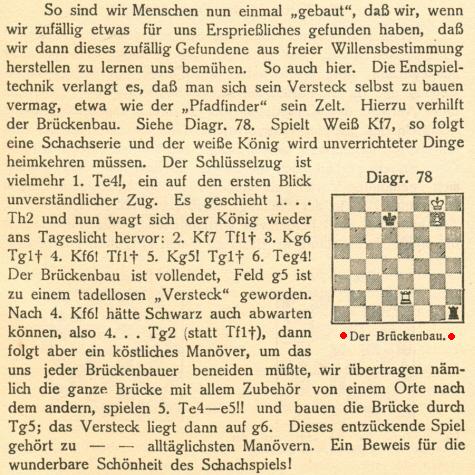
Concerning the ‘Lucena Position’, we also note:
Page 291 of Basic Chess Endings by Reuben Fine (Philadelphia, 1941).
Page 42 of Championship Chess and Checkers for All by Larry Evans and Tom Wiswell (New York, 1953).
(6786)
From Thomas Niessen (Aachen, Germany):
‘I should like to discuss four aspects of the so-called “Lucena Position”. Firstly, the erroneous attribution to Lucena is much older than was previously thought. Secondly, the person who first referred to Lucena was most likely Constantin Schwede. Thirdly, I shall try to explain why the reference is given as “Lucena 96”. Finally, I shall offer a source (a manuscript) containing the “Lucena Position” which is probably older than the following, which appeared in Salvio’s 1634 book Il Puttino:
C.N. 5536 mentioned that the question of whether the “Lucena Position” was in Lucena’s book had been resolved by John Roycroft’s article on pages 160-161 of the April 1982 BCM. According to Roycroft, who was supported by Ricardo Calvo, the position is not in Lucena’s book. That is correct, as anybody can verify nowadays by inspecting a digital copy.
In addition, Roycroft suggested that the error of referring to Lucena’s book stemmed from Johann Berger, on page 273 of his Theorie und Praxis der Endspiele (Berlin and Leipzig, 1922). That volume is a second, expanded edition. The first edition was published in Leipzig in 1890, and I note that the error also appeared there, on page 209:
However, it is probable that Berger merely copied the information about the source from page 629 of the sixth edition of the Handbuch des Schachspiels (Leipzig, 1880), which was edited by Constantin Schwede:
The five previous editions of the Handbuch, all edited by von der Lasa, contained the position and the bridge-building moves, but the reference each time was to Salvio, via pages 245-246 of Sarratt’s translation (London, 1813):
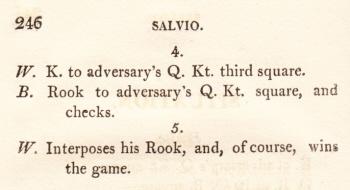
Von der Lasa knew Lucena’s book very well; he found a copy in Rio de Janeiro and made a translation into German, published in the Deutsche Schachzeitung 1858-59 and in the Berliner Schacherinnerungen (Leipzig, 1859).
I therefore believe that Schwede originated the mistaken reference to Lucena. I have checked many of the sources that he lists in the Handbuch, and of those works only two contain the “Lucena Position”, and neither refers to Lucena in connection with it. The position appears, without any reference, on page 729 of Dufresne and Zukertort’s Großes Schach-Handbuch (Berlin, 1872), but there is a reference, to Salvio, on page 185 of J. Preti’s Traité complet, théorétique et pratique sur les fins de parties au jeu des échecs (Paris, 1858):
The precise reference given by Schwede and Berger is “Lucena 96”, and I believe that I can explain this. Antonius van der Linde’s work Das Schachspiel des XVI. Jahrhunderts (Berlin, 1874) presented the contents of several manuscripts, mostly by Polerio. Many of the chess compositions in those manuscripts also appeared in a collection of 372 problems which van der Linde published on pages 202-266 of the first volume of his work Die Geschichte und Litteratur des Schachspiels (Berlin, 1874). For simplicity’s sake I shall call these the “old” problems, in contrast to only 54 “new” ones which he collected from the manuscripts and published at the end of the book, on pages 194-202. These new ones are numbered roughly according to their appearance in one of the manuscripts, and among them is what is now known as the “Lucena Position”, numbered 51:
When van der Linde discussed the first manuscript, collected by Polerio, he gave, on pages 71-72, a list of references for the chess problems therein, and among those references is one that reads “51=L. 96=133”. This means that No. 51 in the first manuscript is the same as “Lucena 96”, as well as being No. 133 in the collection of old problems in the other book.
Thus, if Schwede saw Lucena’s position as No. 51 among the new problems, and erroneously thought that the reference on page 72 meant that position, he could easily assign “Lucena 96” to the “Lucena Position”, happily assuming that he had traced back the position further into the past.
Finally, it is of interest to note how the “Lucena Position” came to be on that list of “new” problems as No. 51. On page 88 van der Linde described the contents of an anonymous problem collection which dated from the sixteenth century (so he assumed, based on the letter in footnote 1 on page 79):
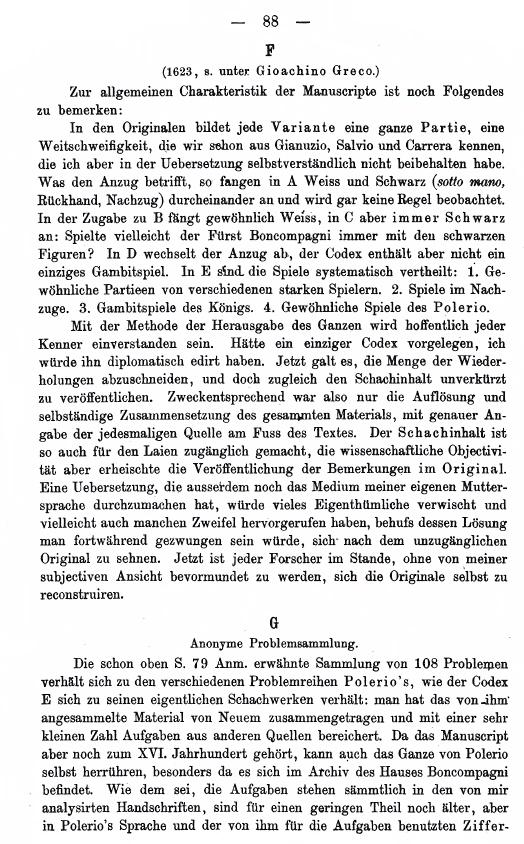
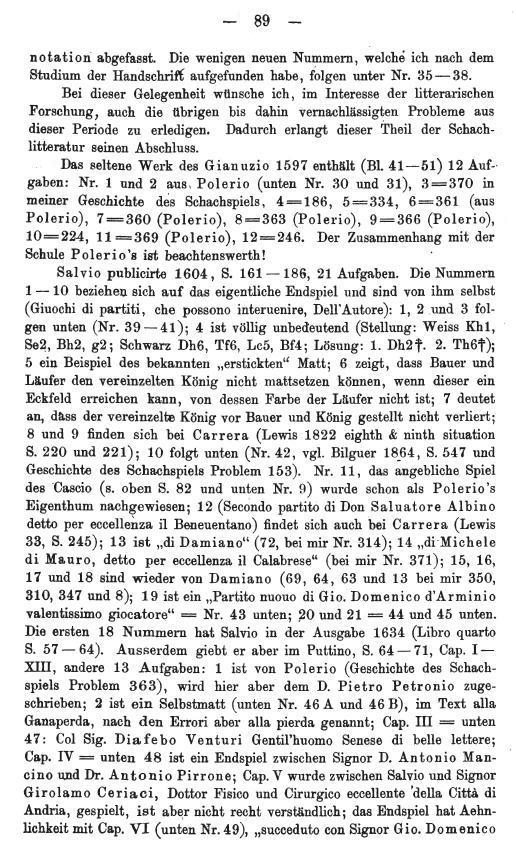
In lines 10-11 on page 90, van der Linde wrote: “Cap. IX ‘Del Signor Scipione Genouino mio maestro’ steht unten unter 51.” In other words, the author of this collection was a student of the inventor of the “Lucena Position”.
As noted by Roycroft, the slightly different name Scipione Genovino was given by Salvio (though omitted by Sarratt).
Since Salvio’s book Il Puttino appeared 1634, the problem collection is probably the older source for the “Lucena Position”, although it is only a manuscript.’
(8044)
To the Chess Notes main page.
To the Archives for other feature articles.
Copyright: Edward Winter. All rights reserved.